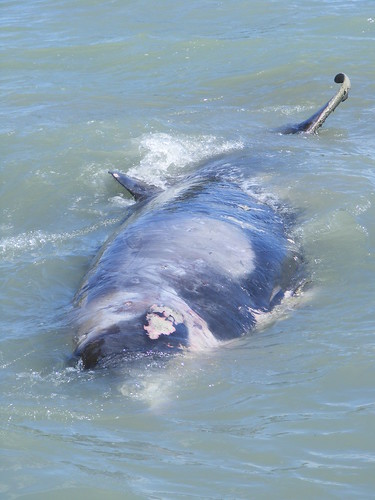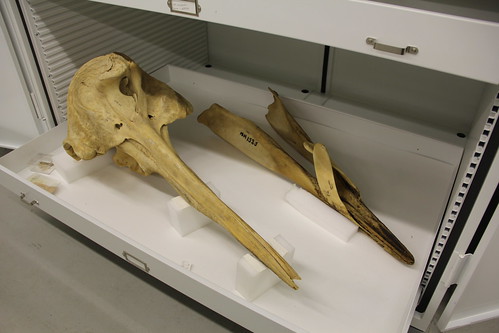Scientific Name: Mesoplodon layardii
Other Names: Layard’s Beaked Whale, Strap-Tooth Beaked Whale
Often exceeding six feet in length, the Strap-Toothed Whale is one of the biggest beaked whales still alive. It is most easily identified by the distinctive marbled colours (usually black and white) and the eruption of two prominent teeth in males. These teeth are sizeable, curving back and extending to above the upper jaw. In older individuals, the teeth can reach lengths of about 30 centimetres, even meeting in the middle. As such, they function more to guide soft foods into the mouth via a sucking process. The females are far more difficult to identify for their absence of these two teeth.
Physical Characteristics
The fusiform body of the Strap-Toothed Whale is mainly black or blue-black (and occasionally brown), with areas of white on the head, back and underside. The head has a slight melon and a long, sloping forehead. The white areas often have yellow scars and patches.
The dorsal fin is small and falcate, and the dorsal fins narrow. The fluke, or tail fin, is broad and triangular, with no central notch, giving it a very straight trailing edge. Adults reach an average length of between five and 6.2 metres, and weigh between one and three tonnes.

Stranded Strap Tooth Whale, Hardinge Road Napier.

Strap Toothed Whale Skull.
Behaviour
Although the Strap-Toothed Whale will sometimes lie at the water’s surface, warming themselves in the sun, they are actually rarely seen in the wild. They are shy, and generally avoid contact with boats.
When they dive, they initiate it with a distinctive sideways roll before dipping below the water and staying there for between 10 and 15 minutes.
The scarring on their bodies indicates that males are aggressive with one another.
The Strap-Toothed Whale often travels alone, but may move in groups of up to three individuals.
Where to Find Them
This whale species favours the cold temperate waters of the Southern Hemisphere. Most strandings have occurred in New Zealand, Australia and Tasmania. However, there have been some isolated reports of strandings in South Africa and South America.
Diet
The Strap-Toothed Whale feeds on soft prey that does not require chewing. This is basically limited to squid.
Threats
Because so little is known about the Strap-Toothed Whale, their threats remain unknown. Of course, issues like pollution, whaling, fishing nets and development always pose a threat to the wildlife that shares this planet with us.
For more information, please go: HERE

